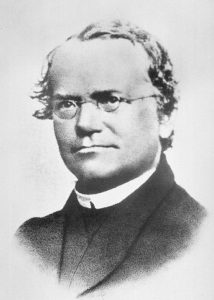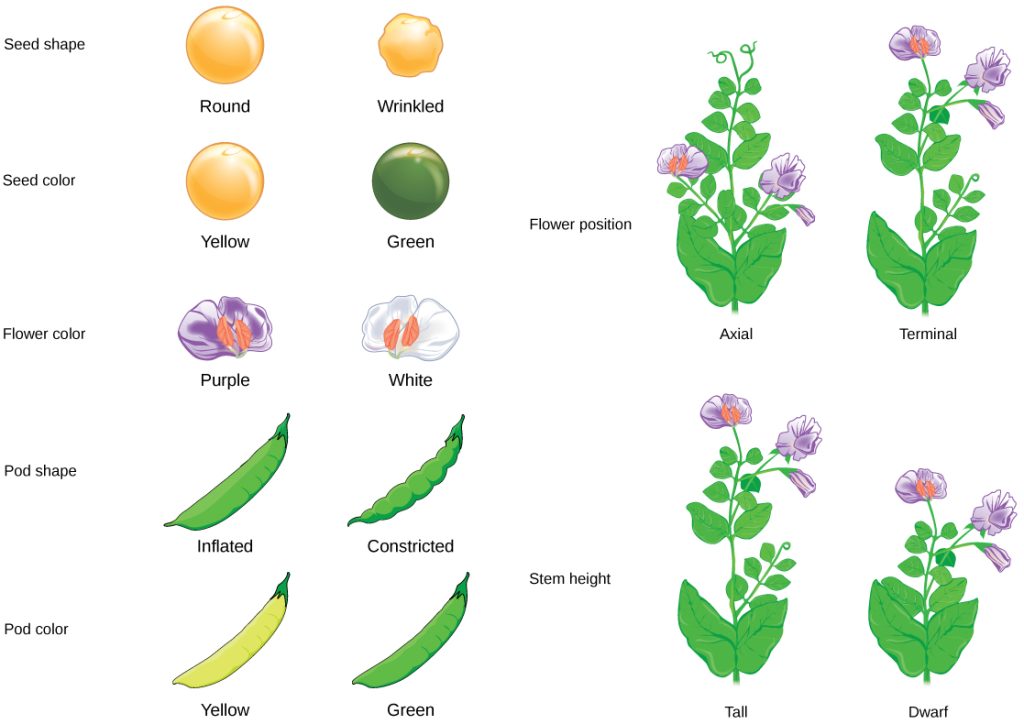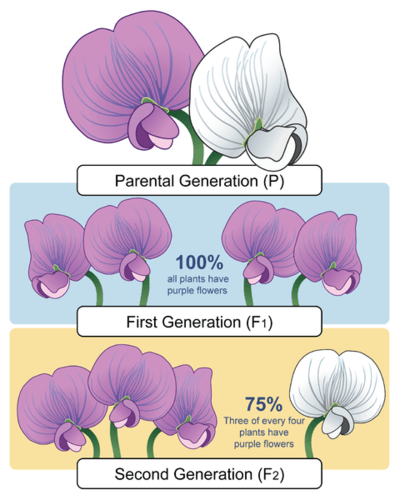8.1 Laws of Inheritance

These purple-flowered plants are not just pretty to look at. Plants like these led to a giant leap forward in biology. They’re common garden peas, and they were studied in the mid-1800s by an Austrian monk named Gregor Mendel. Through careful experimentation, Mendel uncovered the secrets of heredity, or how parents pass characteristics to their offspring. You may not care much about heredity in pea plants, but you probably care about your own heredity. Mendel’s discoveries apply to people, as well as to peas, and to all other living things that reproduce sexually. In this concept, you will read about Mendel’s experiments and the secrets of heredity that he discovered.

Mendel and His Pea Plants
Gregor Mendel (Figure 8.1.2) was born in 1822. He grew up on his parents’ farm in Austria. He did well in school and became a friar (and later an abbot) at St. Thomas’ Abbey. Through sponsorship from the monastery, he went to the University of Vienna, where he studied science and math. His professors encouraged him to learn science through experimentation and to use math to make sense of his results. Mendel is best known for his experiments with pea plants (like the purple flower pictured in Figure 8.1.1).
During Mendel’s time, the blending theory of inheritance was popular. According to this theory, offspring have a blend (or mix) of their parents’ characteristics. However, Mendel noticed plants that weren’t a blend of the parents in his garden. For example, a tall and short plant had either tall or short offspring, not medium in height. Observations such as these led Mendel to question the blending theory. He wondered if there was a different underlying principle that could explain how characteristics are inherited. He decided to experiment with pea plants to find out. In fact, Mendel experimented with almost 30 thousand pea plants over the next several years!
Why Study Pea Plants?
Why did Mendel choose common, garden-variety pea plants for his experiments? Pea plants are a good choice because they are fast-growing and easy to raise. They also have several different characters. A character is a heritable feature that varies among individuals. Pea plants have seven characteristics: seed shape and colour, flower colour, pod shape and colour, flower position, and stem height. Each of these characters has two contrasting traits. A trait is a specific variation of a character. For example, the seed shape may be round or wrinkled, and the flower colour may be white or purple.

Figure 8.1.3 Description
This image illustrates the different traits studied by Gregor Mendel in pea plants, showing pairs of contrasting characteristics for each trait. The image is organized into different sections, each depicting a specific trait with its two variations.
Traits and Their Variations
- Seed Shape:
- Round – Smooth and spherical pea seeds.
- Wrinkled – Irregularly shaped and wrinkled pea seeds.
- Seed Colour:
- Yellow – Bright yellow-coloured peas.
- Green – Deep green-coloured peas.
- Flower Colour:
- Purple – Flowers with purple petals.
- White – Flowers with white petals.
- Pod Shape:
- Inflated – Smooth and full pea pods.
- Constricted – Pea pods that appear pinched and uneven.
- Pod Colour:
- Yellow – Light yellow-green coloured pods.
- Green – Standard green-coloured pods.
- Flower Position:
- Axial – Flowers growing along the sides of the stem.
- Terminal – Flowers growing at the ends of the plant’s stem.
- Stem Height:
- Tall – Pea plants with long stems.
- Dwarf – Pea plants with short stems.
To research how characteristics are passed from parents to offspring, Mendel needed to control pollination, which is the fertilization step in the sexual reproduction of plants. Pollen consists of tiny grains that are the male sex cells (or sperm) of plants. A male flower part called the anther produces them. Pollination occurs when pollen is transferred from the anther to the stigma of the same or another flower. The stigma is a female part of a flower, passing pollen grains to female gametes in the ovary.
Pea plants are naturally self-pollinating, which is another reason they are a good choice for genetics experiments. In self-pollination, pollen grains from anthers on one plant are transferred to stigmas of flowers on the same plant. The flower petals remain sealed tightly until pollination is completed to prevent the pollination of other plants. The result is true-breeding pea plants, which are plants that always produce offspring that look like the parent. By experimenting with true-breeding pea plants, Mendel avoided the appearance of unexpected traits in offspring that might occur if the plants were not properly bred.
Mendel was interested in the offspring of two different parent plants, so he had to prevent self-pollination. He removed the anthers from the flowers of some of the plants in his experiments. Then, he pollinated them by hand using a small paintbrush with pollen from other parent plants of his choice. When pollen from one plant fertilizes another plant of the same species, it is called cross-pollination. The offspring that result from such a cross are called hybrids. When the term hybrid is used in this context, it refers to any offspring resulting from the breeding of two genetically distinct individuals.
Mendel’s First Set of Experiments

Figure 8.1.4 Description
A diagram showing flower colour inheritance in three generations of orchids. The top section labelled “Parental Generation (P)” shows one purple-flowered plant and one white-flowered plant. The middle section, “First Generation (F1),” shows four purple-flowered plants with a label indicating that 100% of the F1 generation has purple flowers. The bottom section, “Second Generation (F2),” shows three purple-flowered plants and one white-flowered plant, with a label stating that 75% (three out of four) have purple flowers. The diagram illustrates Mendelian inheritance, where the purple trait is dominant, and the white trait is recessive.
At first, Mendel experimented with just one character at a time. He began with flower colour. Mendel cross-pollinated true-breeding purple-flowered and true-breeding white-flowered parent plants. The parent plants in the experiments are called the P (for parent) generation.
The offspring of the P generation are called the F1 (for filial, or “offspring”) generation. As shown in Figure 8.1.4, all of the plants in the F1 generation had purple flowers — none of them had white flowers. Mendel wondered what had happened to the white-flower trait.
He assumed that some type of inherited factor produces white flowers and others produce purple flowers. Did the white-flower factor just disappear in the F1 generation? If so, then the offspring of the F1 generation — called the F2 generation — should all have purple flowers like their parents.
To test this prediction, Mendel allowed the F1 generation plants to self-pollinate. He was surprised by the results. Some of the F2 generation plants had white flowers. He studied hundreds of F2 generation plants, and for every three purple-flowered plants, there was an average of one white-flowered plant (75% purple flowers and 25% white flowers). Based on these observations, Mendel proposed that characters are controlled by “hereditary factors” that exist in pairs, with one being dominant and overpowering the other. In the case of flower colour, purple was dominant over white.
Mendel did the same experiment for all seven characters. In each case, one trait disappeared in the F1 plants, later reappearing in the F2 plants. In each case, 75% of F2 plants had one trait, while 25% had another.
Law of Segregation
Mendel then formulated his first law of inheritance, the law of segregation, which states that hereditary factors (now known as alleles) separate during the formation of gametes, ensuring that each gamete carries only one allele for each character.
Law of Dominance
Similar to his results for flower colour, Mendel observed for all 7 characters that when two different alleles are present in an individual, one allele would always mask the expression of the other. This principle is known as the law of dominance. The allele that is expressed is called the dominant allele, while the allele that is not expressed is the recessive allele.
Mendel’s Second Set of Experiments
Mendel wondered whether different characters are inherited together. For example, are purple flowers and tall stems always inherited together, or do these two characteristics show up in different combinations in offspring? To answer these questions, Mendel next investigated two characters at a time. For example, he crossed plants with yellow round seeds and plants with green wrinkled seeds. The results of this cross are shown in Figure 8.1.5.

Figure 8.1.5 Description
The graphic shows a Punnett square diagram illustrating a dihybrid cross between pea plants with round yellow seeds (genotype RRYY) and wrinkled green seeds (genotype rryy).
- At the Parental Generation (P) level, the cross is between RRYY and rryy. Their gametes (RY and ry) combine to form the First Generation (F1), producing offspring with the heterozygous genotype RrYy (round yellow).
- The Second Generation (F2) is represented by a 4×4 Punnett square showing the combinations of gametes from two RrYy parents.
- Each row and column represents the gametes (RY, Ry, rY, ry), and the 16 squares inside show the resulting genotypes.
- The genotypes include combinations such as RRYY, RRYy, RrYY, RrYy, rrYY, rrYy, Rryy, and rryy.
- The phenotypic outcomes are represented with colors: yellow circles for round yellow seeds and green circles for wrinkled green seeds.
The letters R, r, Y, and y represent genes for the characters Mendel was studying. This experiment demonstrates that, in the F2 generation, nine out of 16 were round yellow seeds, three out of 16 were wrinkled yellow seeds, three out of 16 were round green seeds, and one out of 16 were wrinkled green seeds.
In this set of experiments, Mendel observed that plants in the F1 generation were all alike. All of them had yellow round seeds like one of the two parents. However, when the F1 generation plants self-pollinated, their offspring — the F2 generation — showed all possible combinations of the two characters. Some had green round seeds, for example, and some had yellow wrinkled seeds. These combinations of characteristics were not present in the F1 or P generations.
Law of Independent Assortment
Mendel repeated this experiment with other combinations of characters, such as flower colour and stem height. The results were the same as those shown in Figure 8.1.5 each time. The results of Mendel’s second set of experiments led to his next law. This is the law of independent assortment, which states that hereditary factors (which we now call “alleles”) controlling different characters are inherited independently of each other.
Exercise 8.1.1
Text Description
When Mendel was conducting his experiments, the more popular inheritance theory was the ____; which was not supported by his research findings.
Mendel’s first set of experiments involved observing pea blossom colours. Using ____ Mendel fertilized flowers with white blossoms using pollen from flowers with purple blossoms, creating ____.
He found that in the first resulting generation, F1, that ____ of the flowers had purple blossoms. However, when he then created an F2 generation, he found ____ of the resulting offspring had white flowers, and only ____ showed the purple blossoms.
From here, Mendel surmised that there were in fact two alleles for flower colour, and that the ____ allele was dominant to, or overpowered, the ____ allele. He also surmised that each plant had two copies of genes for flower colour, but only one of these genes was passed directly on to the offspring.
This led Mendel to develop his first law of genetics, the ____.
Possible Answers:
- white
- purple
- 25%
- 100%
- cross-pollination
- 75%
- law of segregation
- hybrids
- blending theory of inheritance
Answers:
When Mendel was conducting his experiments, the more popular inheritance theory was the blending theory of inheritance; which was not supported by his research findings.
Mendel’s first set of experiments involved observing pea blossom colours. Using cross-pollination Mendel fertilized flowers with white blossoms using pollen from flowers with purple blossoms, creating hybrids.
He found that in the first resulting generation, F1, that 100% of the flowers had purple blossoms. However, when he then created an F2 generation, he found 25% of the resulting offspring had white flowers, and only 75% showed the purple blossoms.
From here, Mendel surmised that there were in fact two alleles for flower colour, and that the purple allele was dominant to, or overpowered, the white allele. He also surmised that each plant had two copies of genes for flower colour, but only one of these genes was passed directly on to the offspring.
This led Mendel to develop his first law of genetics, the law of segregation.
“5.10 Mendel’s Experiments and Laws of Inheritance” from Human Biology by Christine Miller is licensed under a Creative Commons Attribution-NonCommercial 4.0 International License, except where otherwise noted.

